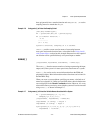
Chapter 2 Linear System Representation
Xmath Control Design Module 2-14 ni.com
discretization methods used based on the specification of each keyword are
discussed in the following sections.
Numerical Integration Methods: forward, backward,
tustins
Xmath provides three methods of numerical integration of a differential
transfer function: the forward and backward rectangular rules, and Tustin’s
rule (also called the bilinear or trapezoidal transform).
To convert the system description from a continuous differential equation
to a discrete difference equation, you approximate the value of the
derivative in the continuous equation over each
dt seconds of time, then
find the area of the geometric region having width
dt and height equal to
the derivative. You can do this in a number of ways, as discussed in
[FPW90].
For the forward rectangular method, you assume the incremental area term
between sampling times k * dt and (k +1)*dt to be a rectangle having
width dt and height equal to the integral form of the differential equation at
time (k +1)*dt. In essence, you get your amplitude estimate for each
rectangle by looking forward, hence the name. The backward rectangular
method arises similarly, except that you get the rectangle’s height by
looking backward and taking the value of the integral at k * dt. The forward
rectangular approach tends to overestimate the incremental area somewhat
and the backward approach tends to underestimate it (though with a
sufficiently small sampling interval, this may not pose a large problem).
The trapezoid rule strikes a balance between these two methods by taking
the average of the rectangles defined by the forward and backward methods
and using that value as the incremental area in approximating the difference
equation.
These approaches can be summarized as substitutions between the
continuous-time Laplace-transform operators and the discrete z-transform
operator z as shown in Table 2-1.
Table 2-2. Mapping Methods for discretize( )
Method of Approximation Continuous to Discrete
Forward rectangular rule:
Keyword:
forward
s
z 1–
dt
-----------
→


















